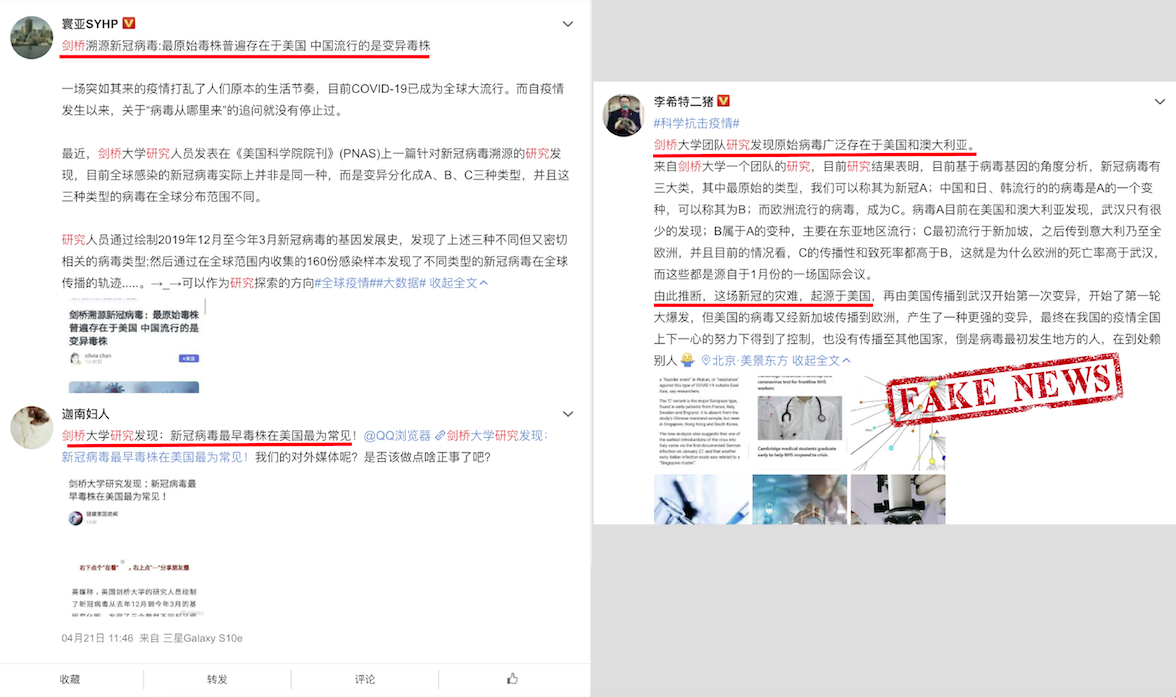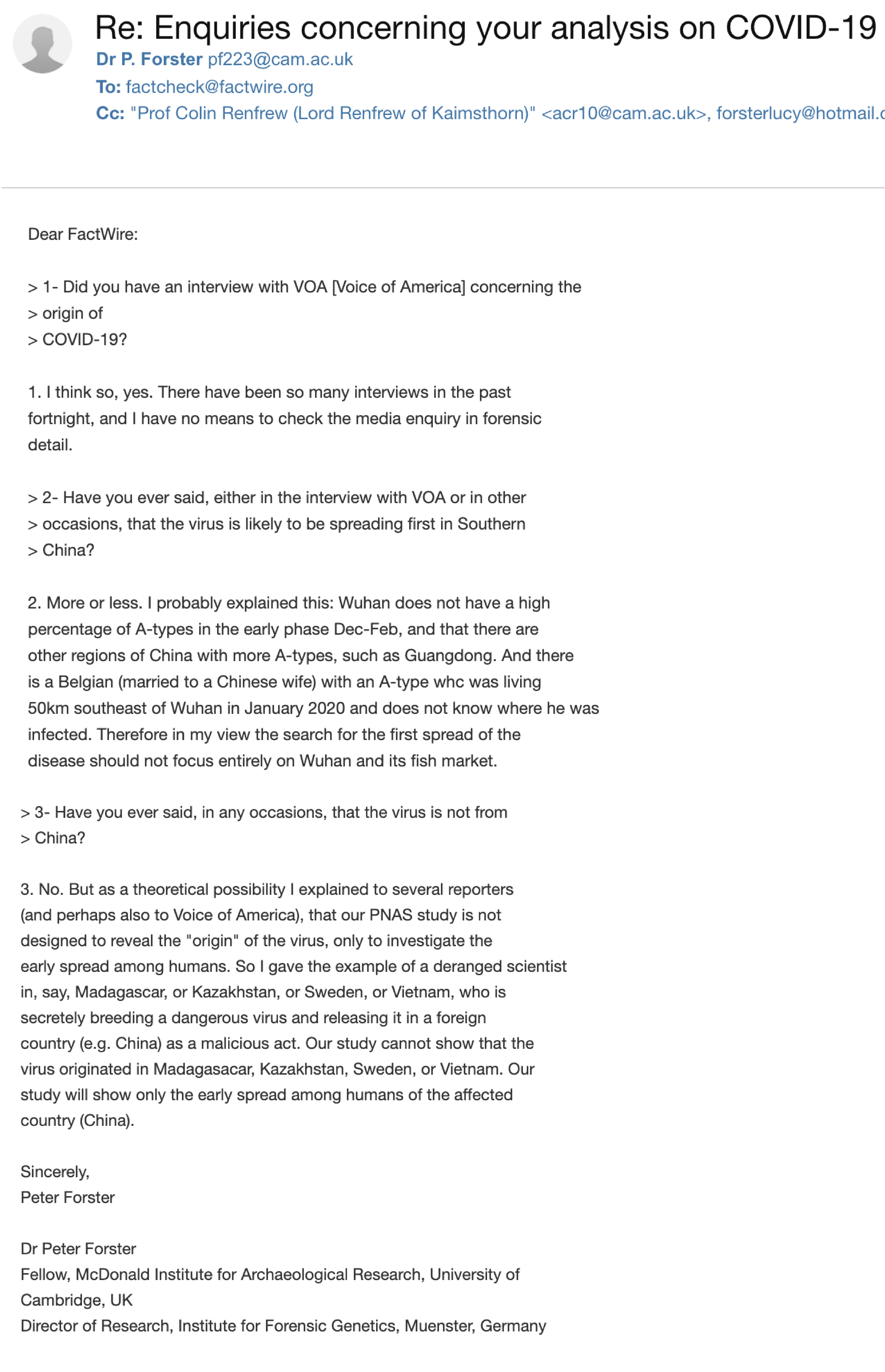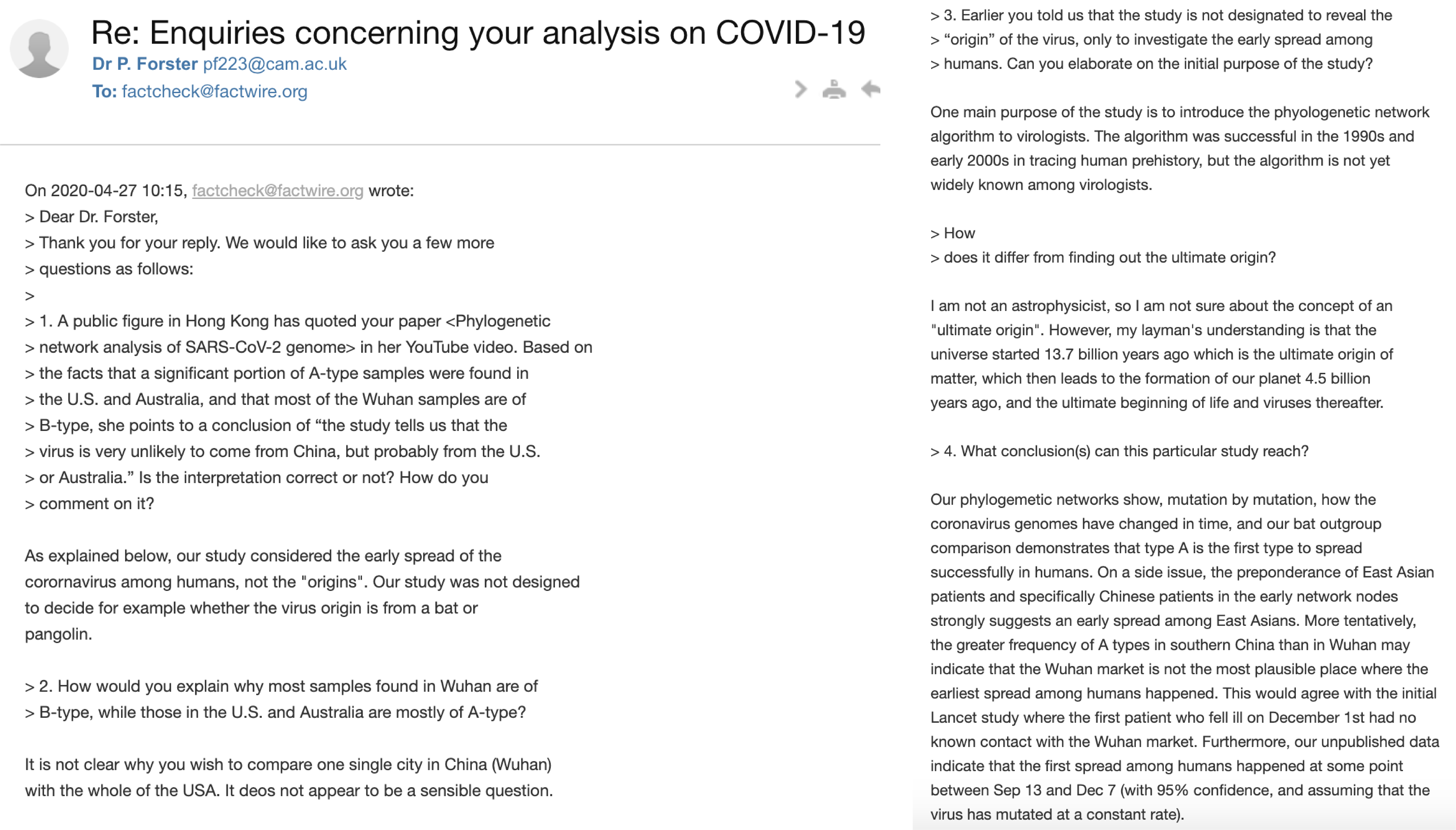FTU Joephy Chan claims in a viral YouTube video that COVID-19’s origin is “very unlikely to be China, but probably the U.S. or Australia”, based on a Cambridge study. The lead author confirms that it is a misinterpretation of the research.

Former Federation of Trade Unions district councillor Joephy Chan misinterprets a study by Cambridge and German scientists, claiming in a YouTube video that COVID-19’s origin is very unlikely to be China, but probably the U.S. or Australia. The mentioned study, however, is not designated to and does not reveal the origin of the virus.
The Chinese video, named “New discovery by British and German scientists uncovers the conspiracy behind Britain and America’s request for compensation from China. Originated in the U.S. and Australia? First case happened last September? Even the U.K. and U.S. are guilty?”, has over 410 thousand views on YouTube to date.
In the video, Chan introduces an academic paper published on the Proceedings of the National Academy of Sciences (PNAS), first saying that it “discovers that the virus was not originated from China”, then quoting a media report on the study, claiming experts “have used scientific ways to trace the origin of the virus”.
“Although type A (of COVID-19’s variants) is found in China as well, it is not the most dominant type of virus in China,” says Chan from 1:58 to 2:05 in the video. At the same time, screenshot of a media report shows “Forster and colleagues found that the closest type of COVID-19 to the one discovered in bats – type ‘A’, the ‘original human virus genome’ – was present in Wuhan, but surprisingly was not the city’s predominant virus type.” Note that Chan mentions ‘China’ while the report mentions ‘Wuhan’.
From 2:05 to 2:29, Chan continues, “the study, in turn, points out that A-type virus is found in Americans who have lived in China. It makes us suspect, whether or not were Americans the first who got the virus from bats and pangolins in China? Moreover, the study says that most patients infected with A-type viruses are from the U.S. and Australia.” Screenshot of another paragraph of the same media report shows: “Mutated versions of ‘A’ were seen in Americans reported to have lived in Wuhan, and a large number of A-type viruses were found in patients from the US and Australia.”
“This makes us doubt, did the virus really originate in China?” She then concludes: “The study tells us that the origin is very unlikely to be China, but probably the U.S. or Australia.”
Chan has been quoting from a Science Daily report on the study <Phylogenetic network analysis of SARS-CoV-2 genomes>, published on PNAS on 8 April. The study was led by University of Cambridge geneticist Dr. Peter Forster.
Since the study was published, Chan as well as several reports found on mainland media platforms have quoted and misinterpreted the results as ‘COVID-19 originated in the U.S.’ and/or it ‘did not originate in China’.
But the study itself is not designated to reveal the virus’ origin, just to investigate the early spread among humans, according to Dr. Forster’s reply to FactWire.
In the study, the virus is classified into three ‘variants’ identified as ‘A’, ‘B’, ‘C’. Type A mutates into type B; type B mutates into type C. Media reports commonly emphasise that ‘A-type strain, being the first type to successfully spread among humans, was mainly found in the U.S. and Australia,’ without also stressing that type A was found in China and other countries as well.
In fact, what is mentioned in the study – “It is noteworthy that nearly half (15/33) of the types in this subcluster, however, are found outside East Asia, mainly in the United States and Australia.” – is focusing on only one of the two A-type subclusters.
T-allele subcluster of type A has samples from four Guangdong patients, three Japanese patients, and two American patients who have reportedly lived in Wuhan. C-allele, the other subcluster, includes 33 samples with five from Wuhan patients, eight from other regions of China and adjacent countries, and 15 from areas outside East Asia, mainly in the U.S. and Australia.
Another common misinterpretation is to suggest ‘China is not the origin’ by quoting that the dominant type of strain in China and Wuhan is B, not A.
Dr. Forster has clarified in an email reply to FactWire that “our study considered the early spread of the coronavirus among humans, not the ‘origins’.”
“Our phylogenetic networks show, mutation by mutation, how the coronavirus genomes have changed in time, and our bat outgroup comparison demonstrates that type A is the first type to spread successfully in humans,” he added, “on a side issue, the preponderance of East Asian patients and specifically Chinese patients in the early network nodes strongly suggests an early spread among East Asians.”
He also pointed out that the percentage of A-types in the early phase in other parts of China, such as Guangdong, is higher than that in Wuhan. “Therefore in my view the search for the first spread of the disease should not focus entirely on Wuhan and its fish market,” he said.
But the first spread is not essentially the same as the origin, explained Dr. Forster. For example, if the virus is bred in somewhere called ‘X’, not until it is brought to ‘Y’ does it start to spread among humans, then the study can only show the early spread of it in ‘Y’. It cannot suggest where ‘X’ is.
He has never said that China is not the origin, though also agreeing that it is theoretically possible.
FactWire has contacted Joephy Chan through Facebook, YouTube and WhatsApp to see if she would delete the video as it contains misinformation. She replied “As (the study) cannot determine the origin, it means that anywhere can possibly be the origin. I am exactly pointing out in the video that even when the origin remains unclear, I wouldn’t call it ‘American virus’ or ‘Australian virus’.”
FactWire followed up by asking how Chan got to the conclusion of “COVID-19’s origin is very unlikely to be China, but probably the U.S. or Australia” as said in the video. No reply has been received.
UPDATE:
A statement from Dr. Forster was posted on University of Cambridge’s website on 30 April, after FactWire published the Chinese version of this report on 28 April. The statement says: “Our analysis published in the Proceedings of the National Academy of Sciences (PNAS) looked at the early spread of the virus in humans. Our analysis was not designed to investigate rumours suggesting the virus itself came from outside China. It is a misinterpretation of our research to suggest that the novel coronavirus originated outside China.”
——————————————————————————————————————–
References:
《Phylogenetic network analysis of SARS-CoV-2 genomes》
https://www.pnas.org/content/early/2020/04/07/2004999117
News report by the University of Cambridge
Joephy Chan’s YouTube video
https://www.youtube.com/watch?time_continue=640&v=w6b_7ZlLTAk
News report by Science Daily
https://www.sciencedaily.com/releases/2020/04/200409085644.htm
Article on Zhi Hu, a mainland media platform
https://zhuanlan.zhihu.com/p/128652780
News report by Ta Kung Pao
http://www.takungpao.com/news/232111/2020/0411/436210.html
News report by Wen Wei Po
http://news.wenweipo.com/2020/04/11/IN2004110027.htm
News report by Voice of America
https://www.voacantonese.com/a/wyn-genetic-research-shows-covid19-first-spread-in-china-20200415-ry/5373168.html



